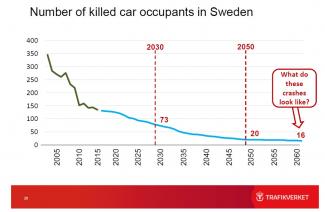How close to zero car fatalities can we get?
Anders Lie from the Swedish Transport Administration has visited the researchers at SAFER to discuss the forecast of traffic safety, based on statistics and knowledge about current technology development.
Vision Zero in Sweden and elsewhere
The Swedish parliament decided back in 1997 on a long term target that no one should be killed or receive long term disability due to a traffic accident. This target is known as “Vision Zero”. This was a bold claim by that time and, still, this strategy is a role model all around the globe. The thought and strategy has been exported to other parts of the world, e.g. to the US. In 2011, the European Commission decided on a similar vision:
“By 2050, move close to zero fatalities in road transport. In line with this goal, the EU aims at halving road casualties by 2020. Make sure that the EU is a world leader in safety and security of transport in all modes of transport.”
The Unitied Nations integrated road safety as a part of the global sustainability targets in 2015. This means that most countries now have traffic safety on the political agenda.
It looks promising
Anders Lie tells us that the forecast for how the fatalities and serious injuries traffic will decrease in the future looks very good.
"Two thirds of all fatalities can be eliminated when we replace today's car fleet to modern cars with high crash safety and active safety systems."
If making this assumption on status of vehicle and road safety in 2030:
• Cars model year 2030 or later have 5 stars (with today’s system) in Euro NCAP’s rating, including standard automatic emergency braking and autonomous emergency steering.
• Median barriers in speed areas higher than 80 km/h and daily traffic more than 4000 vehicles.
• Roundabouts in urban intersections.
• Safe road sides on speed areas on all roads with speeds higher than 80 km/h.
Then there are likely 73 fatalities per year left by 2030 and if development continues in the same positive direction, only 16 deaths remain in 2060.
Which 16 fatalities are still remaining in 2060?
A realistic assumption for 2060, based on what we know in today's statistics could be that these 16 fatalities would happen due to:
• 6 level crossings (5 without barriers)
• 5 extreme violations
• 3 head-on crashes with a heavy goods vehicle
• 2 disease-related cases
If car technologies planned to be implemented in 2030 will be implemented five years earlier, in 2025 instead, approximately 150 lives more can be saved until 2060. On top of that, if car scrapping program for cars older than 15 years was implemented in 2030, 380 fatalities more can be prevented.
A conclusion to “how close can we get” is according to Anders Lie:
“Very close, but we need the improved road infrastructure too. With full implementation of current safety strategies for a safe road transport system we can get close to zero car fatalities by 2050. And we can get there even faster with, for instance, car scrapping programs”.
Anders Lie's PPT is available to download below.

